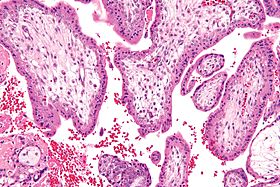Chorionic villus sampling
| Chorionic villus sampling | |
|---|---|
| Intervention | |

Micrograph showing chorionic villi - the tissue that is collected in CVS. H&E stain.
|
|
| ICD-10-PCS | 16603-00 |
| ICD-9-CM | 75.33 |
| MeSH | D015193 |
| MedlinePlus | 003406 |
Chorionic villus sampling (CVS), sometimes called "chorionic villous sampling" (as "villous" is the adjectival form of the word "villus"), is a form of prenatal diagnosis to determine chromosomal or genetic disorders in the fetus. It entails sampling of the chorionic villus (placental tissue) and testing it for chromosomal abnormalities, usually with FISH or PCR. CVS usually takes place at 10–12 weeks' gestation, earlier than amniocentesis or percutaneous umbilical cord blood sampling. It is the preferred technique before 15 weeks.
CVS was performed for the first time by Italian biologist Giuseppe Simoni, scientific director of Biocell Center, in 1983.
Use as early as 8 weeks in special circumstances has been described.
It can be performed in a transcervical or transabdominal manner.
Although this procedure is mostly associated with testing for Down Syndrome, overall, CVS can detect more than 200 disorders.
Possible reasons for having a CVS can include:
The risk of miscarriage in CVS is estimated to be about 1-2%. Apart from a risk of miscarriage, there is a risk of infection and amniotic fluid leakage. The resulting amniotic fluid leak can develop into a condition known as oligohydramnios, which is low amniotic fluid level. If the resulting oligohydramnios is not treated and the amniotic fluid continues to leak it can result in the baby developing hypoplastic lungs (underdeveloped lungs).
Additionally, there is also mild risk of Limb Reduction Defects associated with CVS, with the risk being higher the earlier the procedure is carried.
...
Wikipedia
